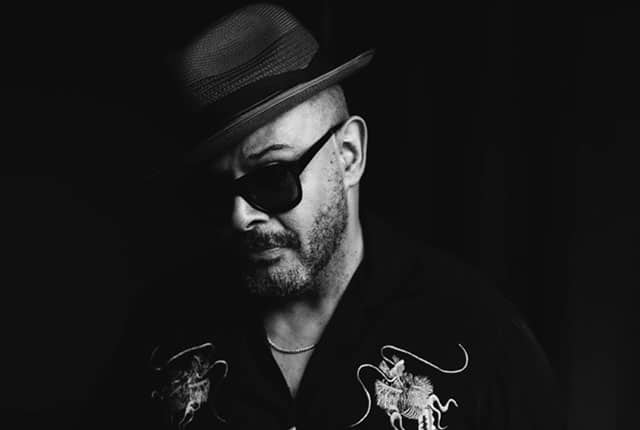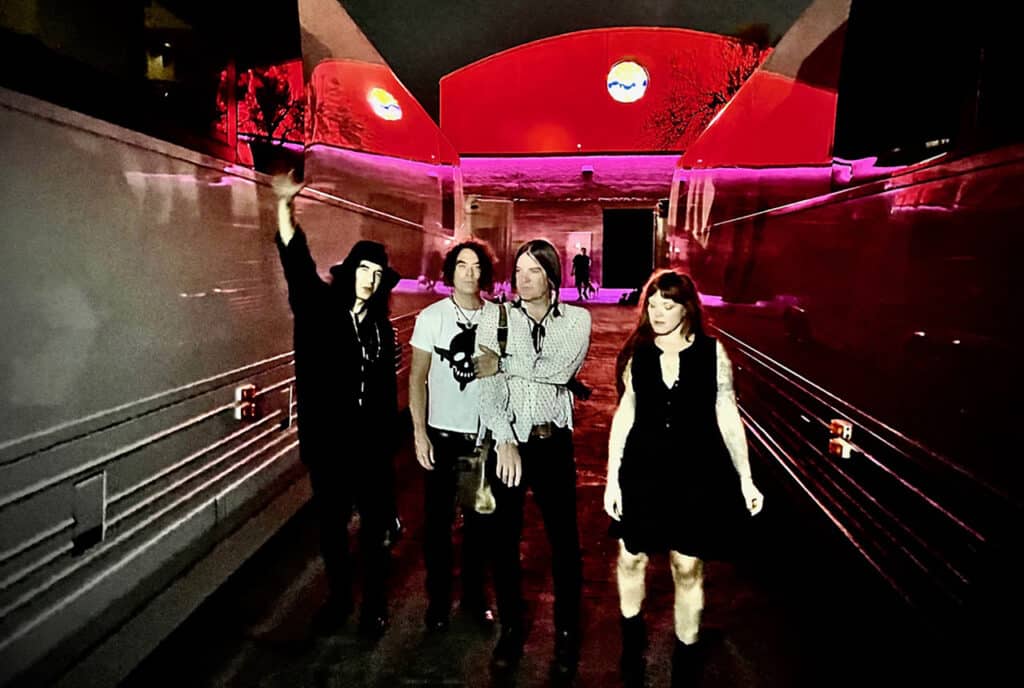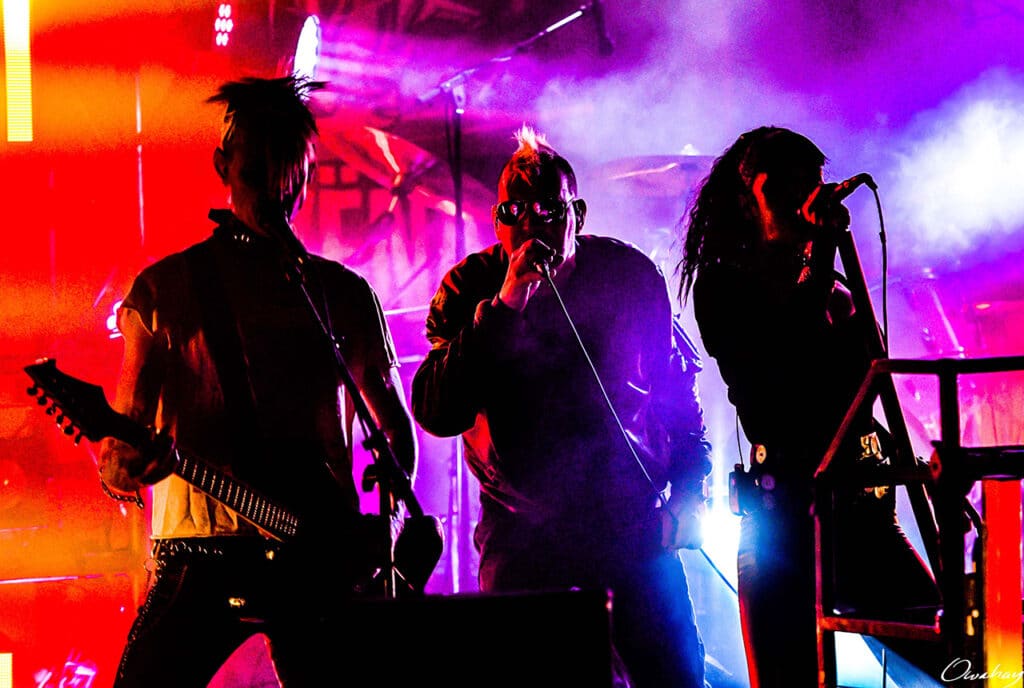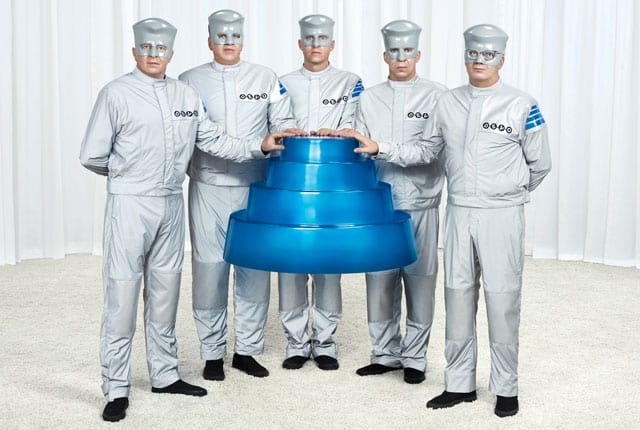Having wrapped up another stint with Nick Cave and the Bad Seeds, British multi-instrumentalist / artist Barry Adamson has turned his attention back to his solo career with “Know Where to Run.” The new album is a part of an audio/visual project rooted in a series of photos Adamson took during the last Bad Seeds tour of America. Some of the images appear in the CD booklet, and the plan is to flesh out the visual aspect later this year through a series of gallery shows and a book.
Adamson first became known as the bassist for Magazine, the highly acclaimed band formed by original Buzzcocks vocalist Howard Devoto. He was also part of Visage before joining the original lineup of Nick Cave and the Bad Seeds. Adamson went solo in 1987, putting out his own music and contributing to many soundtracks. He also makes movies himself; his latest short film, “The Swing The Hole and The Lie” has been screened at Cannes and other festivals.
Interviewed over Skype, Adamson talked about his new project, returning to his previous bands, and more.
Your new album, “Know Where to Run,” is accompanied by a series of photos you took. Could you talk about how that visual side of the project came about?
Well, it was an odd one. Normally, you are inspired by getting together melodies, chords and sounds, and you start to see a little body of work starting to appear. But this came about another way all together. I was on tour with Nick Cave and the Bad Seeds across America for quite a few months. I got to go right across and up and down the country. I had a pro camera with me, and I just thought I’d use it for snapshots—just grab a few memories, that sort of thing. But they started to become little pieces of artwork in their own way, and they started to inspire an idea, which was to try to discuss in song form different states of the human condition and different states across America. Obviously, with my soundtrack leanings, I’ve got a catalog that moves around from genre to genre, and this was no exception. But I feel that this has got a little bit more license due to that fact that it was inspired by those different settings. So, the photobook kind of led it, really.
Were you doing much actual songwriting on the road?
Funnily enough, we’d be somewhere …. like with the song “Come Away,” I’d recently seen a documentary about the 70s in LA—the sort of troubadour scene. Everybody knew everybody; everybody was writing songs and bumping into each other. Jackson Browne, Joni Mitchell, David Crosby, and a bunch of others, and I thought, “Wow, what an amazing time and an amazing setting,” so I started to wonder…. I don’t know what came first, to be honest. I’d get out a piece of software, on the telephone even, and start writing. And I wrote the chorus to “Come Away.” Then I put a beat to it, and then we added a break. I’d transfer what I had done to a computer and it grew from there. And then I had bits in the library where I thought, “Well, that maybe could be involved with this idea.” It started to build over time, really.
Being a filmmaker as well, did you consider shooting video rather than just photos?
No. Sometimes art projects lead themselves. It was pretty much that way—the photos led into the songs. I just figured I would follow my hunch. That seemed to be where it wanted to take me, so I went with it.
So the photobook component will be out later in the year?
Well, in the album there is a 35-page booklet, a sort of hint of what is to come. Later in the year, probably in October or November, I’m going to try to get around to a few places and have little gallery installations where prints and I suppose coffee table books can be bought. I’ll probably play a few songs from the record. I’d like to show up to as many places as I can, really—kind of like a tour but in a different genre.
Did you consider people who might buy the album digitally and never see the booklet?
Yeah, I guess you can’t be all things to all people. I’d love to be. Perhaps when the exhibition comes around, I’ll do a website and a digital marketing presentation so people can start to get involved that way as well. It’s giving the album a bit of a longer life in that sense.
After the Nick Cave tour, how long did it take you to finish the album?
It took me about 9 months to complete the album. As there always are with these things, there were probably about 19 or 20 song ideas. We actually ended up with 10, but I had to remove one because the mastering guy said, “Look, if you take one song off, we can get better bottom-end, because you’ve got such heavy bass.” So that was a compromise, but I think that the record itself sounds great. The ideas had formed before that, but I initially went in for 9 months and then came out with the album pretty much done.
Were you totally focused on it, or were you working on other things as well?
After the extensive touring with Nick, I was sort of making up for the time away by just being here with that record and no other projects coming.
Did you play most of the instruments?
I always like to start from the ground up and sketch everything. And then the sketches sort of get colored in. So, for example, what I was saying about using the telephone software for “Come Away,” some of that still exists on the actual finished track. I get the sketches to a place that I’m happy with and then get in a band of guys that I work with all the time. I’ve worked with them on the last three records. A bass player named Iain Ross, a drummer named Johnny Machin, and a guitarist named Bobby Williams. I also add in other people based on who can bring something to the table. But they are the staple people. I indicated how the drums might be, and then Johnny does it and brings something else to the table. Same with the bass, though being a bass player myself I’ll lay down more things. But Iain is quite dexterous and he’ll do things I wouldn’t think to do. So we kind of combo up in that way.
You mentioned having more songs than you needed; do you think the others will get used at some point?
It’s funny because you think, “Oh, I’ll do something with that,” but you never do. I don’t know why. It doesn’t make it for a reason. But then, sometimes, like maybe in a five-year period, maybe with an instrumental or something, you think, “Ah, that’s got the grains of something,” so it has another life again. But it’s very rare. I listened to some of the demos the other day and thought, “That’s a pretty good song,” but for some reason, it’s just never going to see the light of day.
There are maybe a couple of commercials here and there that were parts of tracks. I worked on a commercial for jeans where I was playing a slide guitar and had a part that I thought should be developed, but it ended up just being what it is [commercial music]. But the other way around, I was asked to do a commercial and then right at the very end they said, “Sorry, we want to use John Cale.” The piece of music became a track called “‘The Big Bamboozle.” I think it’s been used in something like 10 different TV spots. It’s just become a staple for some of the shows on the BBC. It’s funny—it got extra life after its initial rejections. Sometimes you’re asked to submit things, and you have something just sort of lying around. It’s hard to put your finger on it; what came first—the chicken or the egg? It’s a bit like that.
How has the evolution of musical and studio technology over the year affected how you work?
I try to keep up with things, and I like the user-friendly accessibility. I’m still the same musician, so how I use these tools will be the way I use them. I can remember doing “Moss Side Story” with one synthesizer and a cassette player and plugging that up to the reel-to-reel and having to put sound on top of that. Whereas now, you just pull out your phone and sketch things out. There’s a piece of software I was using the other day where I sketched out a melody and it said, “Do you want to add drums and bass?” There was no tempo or anything, and I just pressed yes and it came back with it. This is remarkable to me; I can sketch out parts. I think that advancement of those tools and the availability of them is not a bad thing at all. People go, “Oh, but that means everybody can use them,” but if you have your own take on things, then that is what’s going to happen.
Do you feel it is very dangerous having too many options with the tools and not knowing when to stop?
I think there is an instinct there. I personally really do advocate for the idea of the sketchbook and then going into the studio. I use a studio where I am in Brighton, in southeast England, that is all analog. We put things through amplifiers and record them through an analog desk. When I started in music, that’s what was going on and that is the kind of sound I want to hear. So pretty much that is what happens. Studio time IS studio time, but of course you can prepare and get yourself pretty much ready. Or you can go in and just sort of experiment. But I like to get myself ready and then use the studio for what it is meant for.
Is it always obvious whether a musical idea lends itself to a vocal driven song or soundtrack piece?
I think an idea presents itself as a song, and the rest of the elements are about supporting that vocal, even though at the end of the day you might sort of have an instrumental that might be used for television or something. With soundtrack work, I am always looking for something that leads the line and pulls you in by what it is doing. I think with a song, the vocal is the thing that does that—it’s the thing that we all respond to, the language and melody. I’m trying to think of a case where I just took the vocal off something and it became an instrumental, but I can’t think of anything. I pretty much set out and know if something is a vocal or instrumental.
How did you come to return to Nick Cave and the Bad Seeds after being away for many years?
It was a funny situation, as it had been 30 odd years or something. Thomas, their drummer, was unwell and at the same time they’d changed personnel, with one of the mainstays from even when I was there, Mick Harvey, leaving. So I think there was a hole there. In those instances, you sort of turn to what you know. I was there before, at the same time as Mick, and I had a multi-instrumental thing going on then, so they asked if I could do that again, but they wanted to factor in the drums and keyboards, so it was a little bit different this time. I played a little bit of drums the first time around, but this time I was almost like the second drummer.
Was there any hesitation in going back?
Yeah, there was. It was funny; Nick asked me, and I said no; then he called me about an hour later and I said yes, after having thought about it. To be honest with you, I thought it was going to be a few months but it ended up being a few years, which kind of surprised me. I kind of got into it as well, but then I felt that I really needed to take the time [to do my own music]. I couldn’t see myself doing both. Nick Cave and the Bad Seeds is a very all-or-nothing kind of package. Although people go off and do things and they do their film work, once you’re in there, it’s quite consuming and your concentration level is at 150% at all times. I needed to pull away from things and have space.
Do you see yourself working with them again?
I seem to be back doing my solo work. The way it is with that group, you’re in or you’re not. So “not” becomes a kind of permanent status. But you never know.
Could you discuss your most recent film, “The Swing, the Hole and the Lie”?
Between tours, I got a few people together for a weekend and just shot this idea. I had a script for a 10-minute film, and it went very well. Of course, it gives me a way to make a film that is not overly costly, and I can score it and I can edit it and just have fun with it. Being a filmmaker is an area that I am really interested in. It was quite well received, and it got into quite a few festivals. It played at Cannes, so I think it was a good thing to do.
Do you approach the soundtrack differently on your own films? Were you thinking about the music as you shot it?
I wasn’t really thinking about the music. I remember with the whole opening to this movie, I thought, “I’ve got to set it up; I’ve got to set up the suspense, let people know that this film is slightly dark, so here’s the mood.” And for some reason, it just wasn’t working. And then I found a sort of acoustic guitar track and put it on the front, and it just sat beautifully. It was what was on the radio in the car, as opposed to a soundtrack telling people where this film is at. It was interesting.
You’re curating a soundtrack event at a new Manchester arts center. Could you elaborate on that?
HOME is a new arts center in Manchester that opened just over a year ago. And they’ve got a multi-cinema complex with theaters and spaces for art, restaurants and cafes. It’s a beautiful place, really. They have different seasons there. I’ve been invited along with the head of film there, Jason Wood, to co-curate a soundtrack season. So it will be films where the soundtrack is something to be noted. I’ll go down there and introduce the whole thing and try to make people aware of what the properties are of the soundtrack and why it is so great.
You returned to Magazine for live shows in 2009. What was that like?
It was so funny because nothing has changed; nobody has changed. Everyone is the same. But what was astonishing to me was that the songs sounded fantastic. They sounded exactly like the used to. When we started “The Light Pours out on Me,” it sounded exactly like it did. And one of the greatest things to me was going out there to play those songs for people that were there the first time, and they were there with a new generation of their kids and stuff. I could see the rapture on their faces, and the kids were looking at their parents as if to say, “Alright, I get it now.” I thought it was a beautiful experience, really, to go back. A lot of times you never get the chance to go back and do things again, and I’ve had the opportunity twice, with Nick Cave and the Bad Seeds, and with Magazine. It makes me feel like a lucky fellow, really.
Was the Magazine reunion conceived as being a one-off or a continuing project?
Well, I think Howard wanted it to be a new thing, really. And so there was a kind of conflict there, because a lot of people wanted it to be what it was. He felt under pressure, probably from himself, to get new material together. Again, I was offered a sort of idea of working for a number of years, which I just couldn’t meet, really. I seem to be the guy who doesn’t stick around, but it’s just impossible for me. They got an album together, but I don’t know what their further plans are. I did have lunch with John, the drummer, a couple of weeks ago and he said that things were slightly on the quiet side, but you never know.
Looking back, the music of Magazine really wasn’t quite like anything else. At the time, did you feel that you were doing something really unique?
Yeah, I did. It’s funny—I was doing a radio show the other day and I was trying to explain this to people. The whole idea was to try to find a uniqueness about yourself that made you different. You can’t make that up; you’ve got to rely on what the people you work with bring to the table. We were very fortunate. I had my thing and John McGeoch, the guitarist, had a very original flair. At the beginning, there was a very interesting keyboard player named Bob Dickinson who wrote half of “Motorcade.” And of course, you’ve got Howard leading it, who is kind of out there in his own uniqueness. So I think that’s what made it stand apart.
For more info on Barry Adamson, visit his official website at barryadamson.com.










